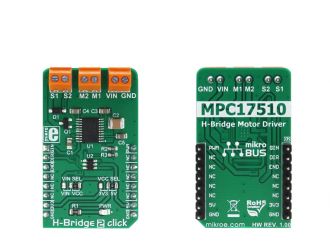
We strongly encourage users to use Package manager for sharing their code on Libstock website, because it boosts your efficiency and leaves the end user with no room for error. [more info]

Rating:
Author: MIKROE
Last Updated: 2018-05-03
Package Version: 1.0.0.0
mikroSDK Library: 1.0.0.0
Category: Brushless
Downloaded: 5588 times
Not followed.
License: MIT license
H-Bridge 2 click can be used to drive a motor by utilizing a specific configuration of the output stage MOSFETs, known as the H-bridge. This configuration enables H-Bridge 2 click to drive a motor with up to 1.2A and 15V, providing control of the speed and direction, as well as the dynamic (rheostatic) braking capability.
Do you want to subscribe in order to receive notifications regarding "H-Bridge 2 click" changes.
Do you want to unsubscribe in order to stop receiving notifications regarding "H-Bridge 2 click" changes.
Do you want to report abuse regarding "H-Bridge 2 click".


Library Description
The library performs the control of the device outputs and in the way, it is possible to perform control of the small DC motor. For more details check the documentation.
Key functions:
uint8_t hbridge2_setOutput( uint8_t outState ) - Function puts outputs (OUT1 (M1) and OUT2 (M2) ) to the desired state.
void hbridge2_enable( uint8_t state ) - Function puts the device in enable or disable state.
void hbridge2_setGOUT( uint8_t state ) - Function controls the state of the GOUT pin (MOSFET GAIN).
Examples Description
The application is composed of three sections:
void applicationTask()
{
hbridge2_setOutput( _HBRIDGE2_OUT1_H_OUT2_L );
Delay_ms( 3000 );
hbridge2_setOutput( _HBRIDGE2_OUT1_L_OUT2_H );
Delay_ms( 3000 );
hbridge2_setOutput( _HBRIDGE2_OUT1_Z_OUT2_Z );
Delay_ms( 3000 );
}
Additional notes and information
Depending on the development board you are using, you may need USB UART click, USB UART 2 click or RS232 click to connect to your PC, for development systems with no UART to USB interface available on the board. The terminal available in all MikroElektronika compilers, or any other terminal application of your choice, can be used to read the message.